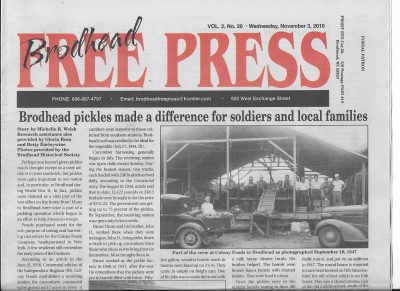Perhaps you haven’t given pickles much thought except as a tasty addition to your sandwich, but pickles were quite important to our nation and, in particular, to Brodhead during World War II. In fact, pickles were claimed as a vital part of the war effort on the home front! Many in Brodhead were once a part of a pickling operation which began in an effort to help American troops.
People purchased seeds for the sole purpose of raising and harvesting cucumbers for the Colony Foods Company, headquartered in New York. A few residents still remember the early years of the business.
According to an article in the June 21, 1956, Centennial edition of the Independent-Register (IR), Colony Foods established a receiving station for cucumbers contracted to be grown on 17 acres in 1944. A March 16, 1944, issue of the IR said that pickles were a government-classed essential food needed for the men serving on the battle front. It noted that cucumbers were easy on the land, easy to grow and harvest, and a sorely needed cash crop. The cucumbers were sold for cash usually under an advance contract to the local pickle packer.
A March 30, 1944, ad told people how to sow and cultivate the plant. They specifically wanted pickles 1.5 inches and up. Sizes could increase dramatically in 24 hours so people were urged to pick frequently. If the pickles were too large, they were unacceptable or brought a low price.
Colony Foods paid people more for the small pickles. A June 1, 1944, ad promised to award two $25 war bonds, in addition to their high pay. The first bond was for the person who produced the best quality cucumbers. The second bond was for the producer of the largest volume. The U.S. Department of Agriculture had asked Colony Foods to increase production to the fullest extent, the ad said. Grade 1 (1-3 inch, 1 inch diameter) per hundred weight was $4; Grade 2 (3-3.5 inches by 1 3/8), $2.50; Grade 3 (3.5-5 inches by 1 ¾), $1.75; and Grade 4 (all straight and crooks to 6.5 inches), 75 cents. In an August 10, 1944, article, Colony Foods defended its pay rates as fair. It said that cucumber growers averaged $1.02 per bushel.
Other ads in June and July advised farmers to plant within the same days and gave tips on how to prevent worm and insect damage. Others simply requested cucumbers.
Wm. Zwiblis, a cooper from New York, stated that the Brodhead cucumbers were superior to those collected from southern stations. Brodhead’s soil was credited to be ideal for the vegetable (July 27, 1944, IR).
Cucumber harvesting generally began in July. The receiving station was open daily except Sunday. During the busiest season, two trucks, each loaded with 240 bushels arrived daily, according to the Centennial story. The August 10, 1944, article said that to date, 12,422 pounds or 248.5 bushels were brought in for the price of $254.25. The government was getting up to 75 percent of the pickles. By September, the receiving station was open only twice a week.
Bruce Timm and his brother, John D., worked there when they were teenagers. John D., being older, drove a truck to pick up cucumbers from those who chose not to bring them in themselves. Most brought them in.
Bruce worked at the pickle factory in 1946 or 1947, after the war. He remembers that the pickles were put in barrels filled with brine. Fifty-five gallon, wooden barrels made in Austria were lined up on 2 x 4s. They came in empty on freight cars. One of his jobs was to wash them out with a milk house cleaner brush. His brother helped. The barrels were former liquor barrels with charred insides. They were hard to clean.
Once the pickles were in the upright barrels resting in their dill mixture, the barrels were once again loaded on rail cars and shipped east.
Bruce pulled boxes off the grader and graded the pickles by size. Gherkins were stamped #1; they were little. Those stamped #2 and #3 were standard size, #4 and #5 were slicer pickles. Farmers were paid per pound for the first, second and third sizes. The farmers had to harvest daily or every other day because they would want the smaller cucumbers to earn more money, he said.
While Bruce worked there, nothing was packaged. He simply hosed off the cucumbers and got them shipped off by rail. He didn’t work there when the pickles were scooped from huge tanks.
Eventually, Colony Foods purchased the round house of the Milwaukee Road, which is said was not really round, and put on an addition in 1947. The round house is reported to have been located on 11th Street behind the old school which is on 10th Street. This was a closed avenue, east of the old middle school, south of the railroad tracks. There were several side tracks. According to an October 1957 Brodhead telephone directory, it was located at 1002 East 6th Avenue. (The phone number was 55!) Canning was added in 1948, employing about 50 people. The Paley family remodeled the building and made it an open building with a big broiler, and tanks and vats for pickles.
An elevator carried the cucumbers to a conveyor where they were graded by size. Sweet gherkins were canned elsewhere. The pickles made in Brodhead were dills.
After the cucumbers were graded they were put into brine for at least two hours. Then women packed them tightly in quart or gallon jars. “Spice boys” put spices in the bottom of the jars. Hot brine was poured over the cucumbers in the jars. The jars were then pasteurized by a vacuum process which took about 30 minutes.
As a teenager, Frank Gombar worked at the pickle factory two different years. He remembers a group of farmers in the Brodhead area being asked if they would participate in the pickle factory. He also grew cucumbers and remembers that picking them soon became a dreaded task. Some farmers grew the cucumbers as a cash crop side business.
Gombar remembers working for fifty cents an hour putting caps on the jars and tightening them.
“A lot of boys, girls, and women worked there,” he said, noting that the factory operated until around Thanksgiving. The big, fist sized pickles that had been placed in vats in salt were picked out, ground up and seasoned to make relish.
Gombar remembered ladies packing washed cucumbers about the size of a thumb into jars. They were paid by how many jars they filled. Middle and high school boys helped unload and weigh bushels of cucumbers. He helped make brine, mixing salt and water.
Gombar said that it was not a high profile operation, but they did barrel up and can a lot of pickles, mostly Kosher dills. He believed that the business changed hands a few times and eventually became Vita Foods.
In the early years, Marv Thostenson, a Brodhead teacher who lived in Edgerton, managed the factory, which operated primarily in the summer months. He was often listed in the ads as the local agent and field man. Amel Borchardt was an assistant in 1944 according to ads. R. Hahn and Stanley Knight were also named in 1944 ads. After Thostenson, Irene Ladwig managed from 1955 until 1967. Under Ladwig, Brodhead became famous in the 1960s for whole pickled baby corn that was eaten cob and all.
According to a 1976 IR from the Brodhead Historical Society, the pickled corn industry moved to an Iowa location. Corn was specifically grown for this purpose. After Ladwig, people from Marengo, Illinois, and Rockford, Illinois, managed the Brodhead factory until it closed in 1970.
The Julius Paley family of Brooklyn, New York, owned and managed the business. Gombar said that residents could tell that the Paleys were city folks because they dressed lavishly. A huge Greek man named Leonard Piccone, Zwiblis, and Sam Oster came from the New York plant to assist. Piccone, an expert pickle man, was extremely strong. (Piccone was mentioned in an August 3, 1944, article. In the 1956 paper, they spelled it Pickony.) A 22-year-old Haitian, who was also very strong, also joined them, Gombar remembers.
Others such as Norm and Lorraine Williams and John Bernstein remember seeing the big vats across the school ground. There was a main room in which the children met to study, from where they could view the factory. Bernstein also said that he liked the pickled baby corn, which he believed was grown locally by the Johnson family.
According to a front page story of the August 13, 1970, IR, the city council received complaints over the pickle factory. An attorney authorized drainage of water from the vats and the building was locked with the attorney’s permission. The council asked the company to dispose of the pickles. The industry was discontinued in Brodhead.
Many who personally worked at the factory are gone now. The Brodhead pickle factory was a busy part of summer life in Brodhead for a few decades, when cucumbers meant pickles which meant money. Some of the boys, including the Timms, saved for Doodle Bug motor scooters to zip around town.
Businesses come and go, but memories are made and shared to help others to know the rich history of their home town. Next time you have a pickle, remember that pickles can play a pretty important part in the history of a nation and a community!
Story by Michelle R. Welsh
Research assistance also provided by Gloria Rosa and Betty Earleywine
Photos Provided by the Brodhead Historical Society
Originally published in the Brodhead Free Press, November 3, 2010.
Discover more from Michelle Kaderly Welsh
Subscribe to get the latest posts sent to your email.




2 Responses
Thank you for the historical details regarding the Brodhead pickle factory. You may be interested in a few clarifying details.
My dad was co-owner of Marengo Ridge Farms (Marengo IL), which was incorporated in 1971 and bought the pickle factory in 1972 to make pickled corn. My summer job in 1974 (I was sixteen, able to drive from Marengo to Brodhead) was to help clean up the abandoned factory, including thousands of gallons of rotten pickles! At the time, the structure was a combination of the barns and vats shown in the historical photos, with a facade (added?) that remains intact today (1098 East 6th Ave). My brother and I recognized the vats in the historical photo immediately (the vats and original structures are gone now). The factory was fully operational by the summer of 1975. Marengo Ridge Farms was dissolved in 1984.
Thanks for sharing and filling in some gaps! Cleaning up rotten pickles must have been a smelly job. I was curious if pickled corn was still a thing, and it is. (I searched for it on Google!) I enjoyed talking with all those who remember this time and was glad to see you join the conversation. Thanks, again.